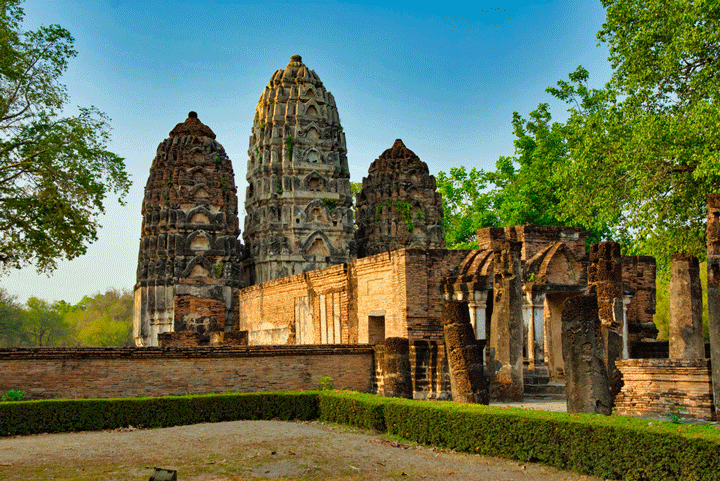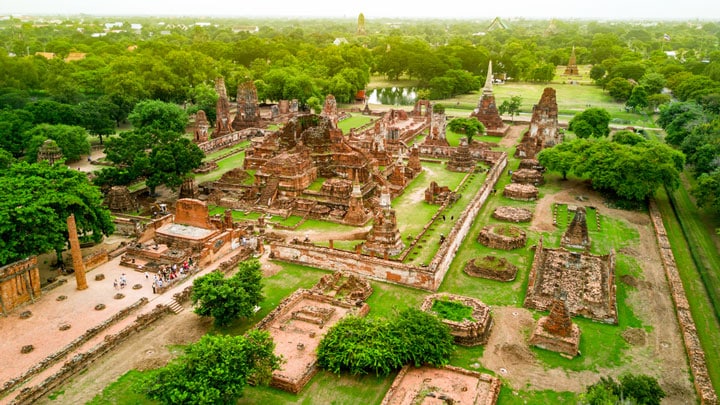The Principality of Sukhothai, the cradle of Thailand
Great moments in history are often born of twists of fate, a confluence of circumstances or the seizing of opportunities. The foundation of the kingdom of Sukhothai – regarded in official Thai historiography as the cradle of modern Thailand – is a good example of this.
In the first half of the thirteenth century, the power of the immense Khmer empire began to wane. This century was a particularly turbulent period for all of Asia. The Mongols invaded China by fire and sword, while Islamic hordes from Central Asia in northern India destroyed the last remnants of Mahayana Buddhism. Events that also had an impact on Khmer civilization. There was, to put it euphemistically, some animosity between Hinduism and Buddhism in the south-eastern corner of Asia at that time.
The great Khmer prince Jayavarman VII who reigned from 1182 to 1219 was a Buddhist, just like his successor Indravarman II. His successor Jayavarman VIII, who ruled the empire from 1270 to 1296, was probably a Hindu who had Buddhist images and reliefs destroyed in an almost systematic manner during his regnum. Apart from the religious tensions, the internal political settlements and feuds in that period also did no good to the internal administrative cohesion of the empire. The succession battles that flared up again and again, in which pretenders to the throne tried to kill each other, slowly but surely paralyzed the center of power and facilitated power grabs by outsiders... Much evidence of this has, unfortunately for historians, been lost in the mists of time, but from the few what we know shows that what happened in this century actually heralded the beginning of the end of the Khmer Empire. The royal center had clearly reached the limits of its possibilities and, moreover, the means of subsistence in the area were exhausted. Due to a combination of erosion, poorly maintained waterways and global climate cooling, crops failed and monsoons were disrupted. Malaria and overpopulation took care of the rest.
Angkor lost its authority, especially on the edges of the empire. Especially in the eastern Champa and in the Malaysian peninsula in the south. But things also started to rumble in the West. At the beginning of the twelfth century, important temple settlements had been founded there by the Khmer princes at strategic places such as along the Chao Phraya River and on the Plateau of Korat. Some of these settlements were mainly populated by Tai-speaking groups. They had been part of the great migration wave that had settled in the eleventh and twelfth centuries from the south of what is now the People's Republic of China in the northern mountainous regions of the Southeast Asian mainland, and which included Lao, Shan and Siamese. These newcomers founded numerous villages where they mainly engaged in agriculture and animal husbandry. Several of these villages gradually formed administrative clusters, a so-called muang which is under the direction of a chief, the chao was standing. In the thirteenth century there was an accelerated migration from the mountains and the hills to the plain of the Chao Phraya and the plateau of Korat. Due to this population increase, more and more Tai speakers emerged muang. They mixed with local Mon and Khmer and managed to take over power in a relatively short time and helped by their demographic preponderance.
Due to the continuing internal problems in the Khmer Empire, here, in the periphery of the empire and without Angkor having much direct control over it, increasingly large muang which soon came under the leadership of Sukhothai. Although Sukhothai remained indebted to Angkor, ethnically it had little to do with the Khmer… Here two of the chao or warlords Pho Khun Pha Muang, the leader of muang Rat and Pho Khun Bang Klang Hao, the leader of muang Bang Yang unexpectedly had opportunities to loosen himself for weeks from the internally weakened Angkor. Angkor's meddling in local affairs and especially the high tax burden made them take up arms. In 1238 they refused to pay tribute to the Khmer any longer and declared their independence. That same year, Pho Khun Bang Klang Hao advanced on Sukhothai, defeated the Khmer garrison and took the city. He thus became the first ruler of the new kingdom of Sukhothai and henceforth called himself Pho Khun Si Intrathit.
Si Intrathit became the founder of the Phra Ruang dynasty which today is considered the first Siamese royal house. His eldest son died in infancy and consequently he was succeeded by his second son Ban Mueang. When he died around 1279/1280 he was succeeded by his youngest brother Ram Khamhaeng. This monarch, who was soon nicknamed 'The Great', is considered the real founder of Siam. He would not only have given Thai a standard alphabet, but also introduced it as the standard language of his empire. He was also responsible for the spread of Theravada Buddhism to the farthest corners of his empire. And Last but not least and thanks to a clever alliance with the princes of Ngam Muang of Phayao and Mengrai of Lan-Na, he successfully repulsed a Mongol invasion and significantly expanded the territory of his principality. At the height of his power, his empire stretched from Martaban (now Myanmar) to Luang Prabang (not In Stock) and until Nakhon Si Thammarat in southern Malacca. The sphere of influence of this kingdom, especially after he had also forced the Khmer to its knees, was larger than that of modern Thailand, although the outlying areas could not always be easily kept under Siamese control. Ram Khamhaeng's reign, marked by prosperity, is therefore rightly regarded as the heyday – the Golden Age – of Sukhothai.
In 1317, after the death of Ram Khamhaeng, his son Loethai followed in his footsteps, but it turned out that he did not possess the same administrative and military skills as his father. It was therefore not long before a number of Sukhothai's vassal states tried to evade Luthai's authority. First Uttaradit in the north, then soon after the Laotian kingdoms of Luang Prabang and Vientiane. In 1319 the Mon state in the West and came in 1321 Roof, one of the oldest cities of the Sukhothai Kingdom, under the influence of Lan-Na. As if that were not enough, the southern city also made Suphanburi separated from Sukhothai early in Luthai's reign.
The rise of Ayutthaya put a final end to Sukhothai era. U Thong, the ambitious son of a Chinese trader and daughter of the leader of the muang Lopburi, subjugated Sukhothai and proclaimed himself ruler of Ayutthaya in 1351. In 1378, Thammaracha II, the ruler of Sukhothai formally handed over his power to Ayutthaya and after the death of Thammaracha IV in 1438, the once mighty Sukhothai was relegated to one of the many provinces of Ayutthaya… Or how it can be in two centuries… .





Perhaps you could have also mentioned, Lung Jan, that Sukhothai is hailed in Thai historiography as the realm where 'democracy Thai style' was practiced.
Dear Tina,
There are more debatable things touted in official Thai historiography….